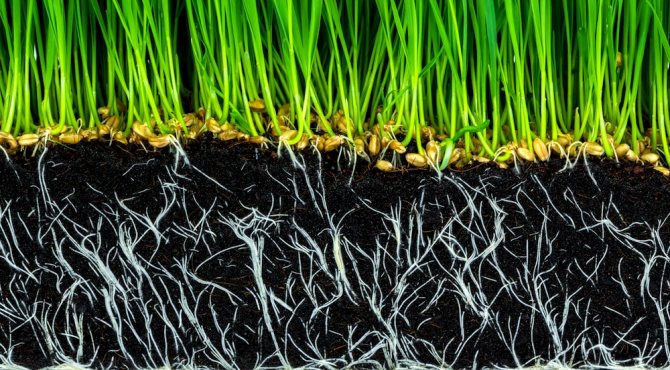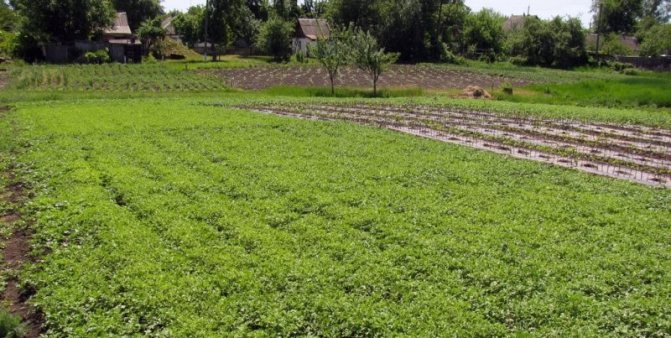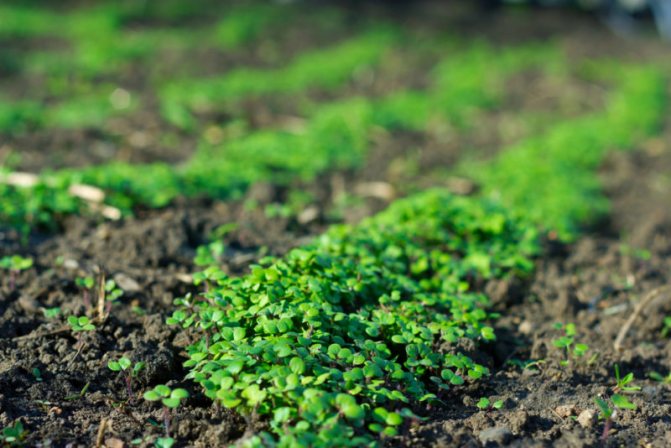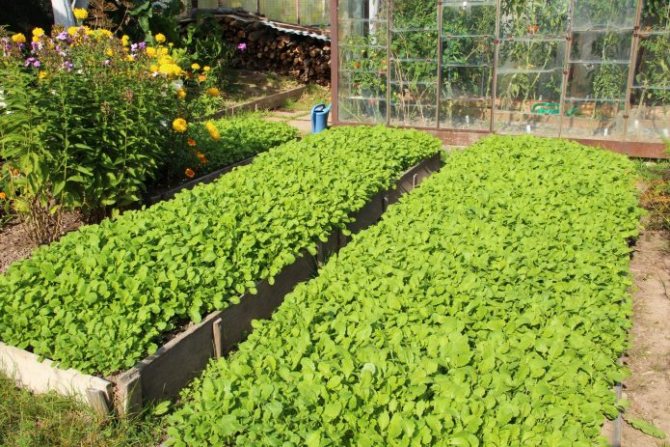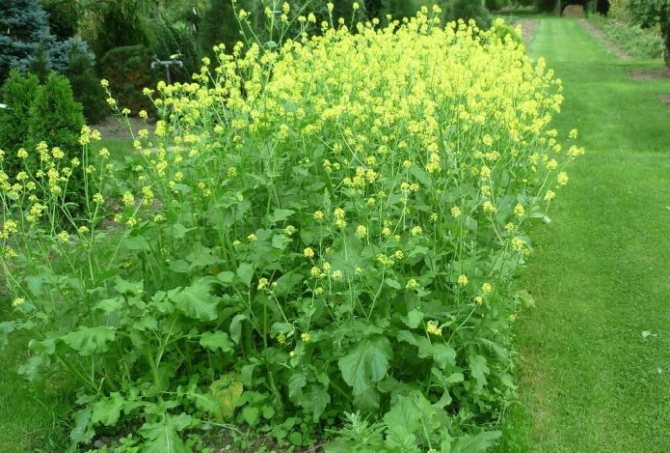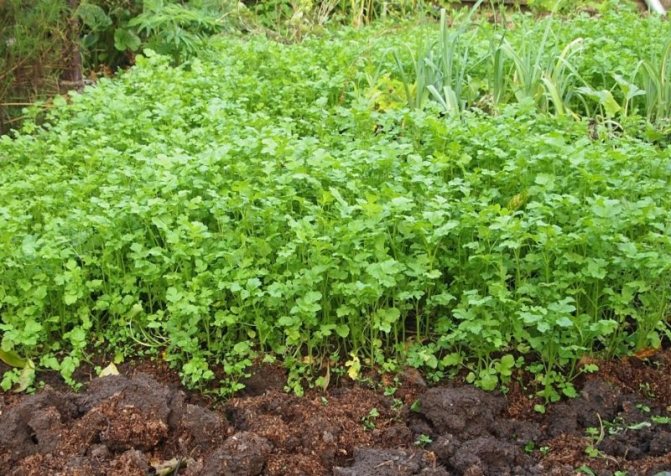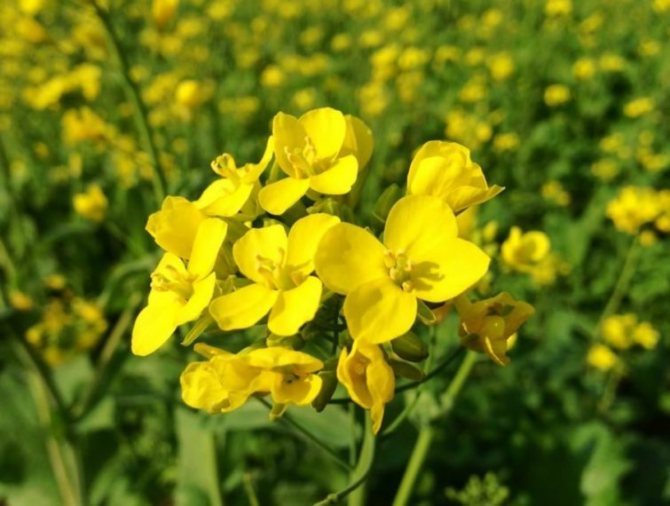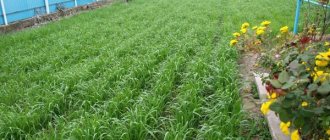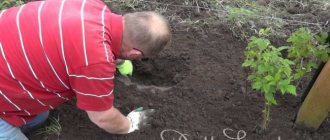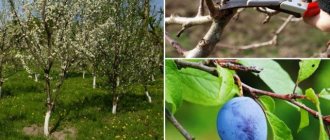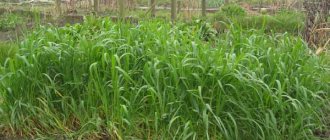Mustard is a popular green manure and fertilizer. Many gardeners are interested in when to sow mustard green manure and when to bury it, to do it in autumn or spring. Knowing this, you can improve the properties of the soil. One of the most successful ways to control weeds is to add green manure to the soil. These are special fertilizers that improve the structure and saturate the soil with nitrogen.
Plant characteristic
The mustard grows rapidly, producing a large amount of greenery and fiber used for mulching the soil. Its roots dissolve well. They convert hard-to-reach nutrients into soluble nutrients for other plants, moving them from the lower layers of the soil to the upper ones. Mustard is often planted to cleanse the soil, as it kills the provocateurs of fungal infections.
White mustard is sown in the aisles of fruit trees and on land.
It is extremely useful in fields where potatoes, tomatoes, peppers, beans, beets, pumpkins, onions, zucchini, peas, garlic, cucumbers, and carrots will be grown.
Mustard is saturated from the soil with hardly soluble phosphates, increasing air exchange and preventing water from evaporating. There is a lot of nitrogen in its leaves.
Mustard is a reliable protector against:
- phytophthora and scab;
- fertile and slugs;
- wireworms;
- putrefactive microorganisms.
Mustard perfectly tolerates cold conditions, so it can be planted in the Moscow region and any region of Russia.
The benefits of mustard for the soil
Mustard green manure contains many useful microelements: starch, proteins, sugars. They protect the soil surface from blowing and erosion. In terms of usefulness, the substance can be compared with manure.
Mustard performs the function of disinfection, increases fertility, protects against spring frosts, diseases and pests.
If you sow mustard seeds in the spring, and plow it as it grows, the soil will be saturated with nitrate nitrogen. He will no longer need additional feeding. In terms of effectiveness, this method can be compared with the introduction of organic matter.
The branched and strong roots of mustard have the ability to loosen the soil as well as plowing equipment. The plant protects the earth from destruction, prevents the leaching of useful microelements from it, releases phosphates, kills weeds and pathogens.
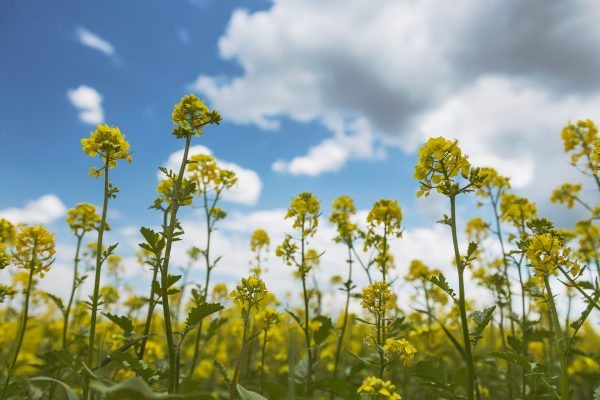
Mustard heals the soil, inhibits the accumulation of pathogenic bacteria, wireworms and nematodes.
The beneficial properties of mustard allow gardeners to increase the positive impact on the soil, spending a minimum amount of money and time.
What are siderates and what are they for?
It is not for nothing that they were called green fertilizer: the contribution of green manure plants to the reclamation of lands used for planting can hardly be overestimated. The peculiarity of grasses of this category is excellent germination, rapid growth, rich green mass within a short period of time, unpretentiousness, the possibility of sowing from spring to autumn. The main tasks of sideering:
- Fertilizing the soil. Rotting green mass, the roots enrich the soil with nitrogen, phosphorus, magnesium, and other necessary macro- and microelements.
- Improving soil structure. After green manure, water and moisture permeability, moisture capacity, looseness, and lightness of the soil increase.
- Weed control. Siderata squeeze out weeds from the beds, do not allow them to grow.
- Control of soil insect pests.Many green manures secreted by phytoncides or alkaloids in the composition create unfavorable conditions for pests, cleansing the soil, protecting the future harvest.
- Suppression of fungal, viral diseases. For these abilities, green fertilizers are called phytosanitary.
- Protection of the surface of the beds from the scorching sun, weathering, washing out.
In small areas, where the land does not have the opportunity to take a break from crops, and the summer resident fully observe crop rotation, sideriding is the only way out. Planting green manures eliminates any undesirable consequences of growing crops for the soil, allowing you not to observe alternation when there is a shortage of planting areas.
When to sow and how
The first step in using mustard as a green manure is the selection of seeds. When buying grain for sowing, it is worth considering the area of land. As a rule, one hectare of soil when sowing is from 7 to 10 kilograms of seeds. The exact figure can be influenced by the weather, sowing time, the state of the fertile soil layer. In hot months, the number of mustard seeds is reduced, in frosty months, they increase.
Prepare the soil before sowing. If the soil is heavy, dig it up and loosen it gently. Mustard seeds are scattered over the soil by hand. You can do it in bulk or in a row. In warm weather, the second method is preferable. In cold weather, sow in bulk. For a more even sowing, the planting material is mixed with sand. If it is not known when it will rain, the soil on which the mustard is planted is watered.
After that, the seeds are buried in the ground using a rake or hoe. After they are poured with water. From above, you can fill the soil with ready-made compost. The first shoots will appear after a week. The owners of fields with high acidity soils should take into account that mustard is not able to interact with high ph.
Features of spring and autumn planting
Wide sowing times provide an opportunity to choose when to sow the mustard.
Since the culture is hardy, it can be planted from spring to late autumn.
If the farmer has chosen spring sowing, he must dig up the soil in the fall, fertilizing it. As soon as the snow melts, they start sowing with mustard. The daytime temperature must be at least 11ºC. Mustard collects a lot of nitrogen, which is laid out in the soil in a form suitable for crops. Sowing can be done both by continuous and ordinary methods. In the first case, the seeds are buried in the soil using a rake. With the ordinary method, the soil is loosened by 5-6 cm, the furrows are cut with a hoe, mustard seeds are put in and covered with mulch to protect them from birds.
Pros of winter planting
Winter sowing is preferable due to several reasons:
- green manure stays in the soil longer, acting on it;
- green manure - excellent protection of the first shoots of vegetables from cold and burning rays;
- after mowing, the culture acts as mulch for the beds;
- time is freed up for sowing early garden plants.
In autumn, mustard is sown very densely - in whole or in rows. If the soil is dry, it is watered. The soil is cleared of weeds and tops; if it is depleted, phosphorus-potassium fertilizers are added. So that the seeds do not germinate during the winter, they must be at rest. For sowing, it is better to choose November: this month there are no thaws anymore. To keep the seeds out of the cold, planting holes can be made deeper.
Influence of organic matter on the soil
If you sow mustard from weeds in the fall, it will affect the fertility of the site. The fact is that organic substances serve as food for soil microorganisms, and these, in turn, produce humus. Thus, it is possible to increase the harvest for the next year practically free of charge.
On depleted soils, it is necessary to increase the number of bacteria. For this, preparations of concentrated microorganisms are used. This is Baikal EM-1 and the like.
Once in the soil, bacteria are taken for eating plant debris, at the same time processing insoluble compounds of nitrogen and phosphorus, converting them into a convenient form for plant nutrition. They also eat weeds that mustard did not germinate.
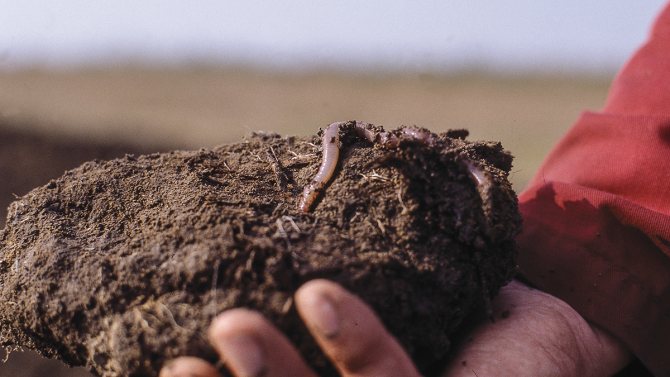

Weed siderata usually have deep roots, so they are especially necessary on sandy soils. The fact is that water quickly flushes out nutrients and cultivated plants cannot get them.
For example, all berries have a superficial root system located no deeper than 30 cm from the surface. It is necessary to feed such crops often and little by little. Thanks to mustard, nutrients from the roots rise to the surface and decompose, provide plants with micro and macro elements.
When to mow and bury
Farmers claim that the plowing of mustard green mass has a beneficial effect on the structure of the soil, improves its moisture capacity and moisture permeability, and reduces the negative effect of the consequences of compaction of the arable layer. Some experts are sure that the digging procedure violates the structure of the soil, and the best way out is not to plow the mustard greens, but leave them on the ground, covered with mulch to prevent drying. This method is useful for winter green manure. So they will not lose, but will multiply their effect - the earth will become very loose in the spring.
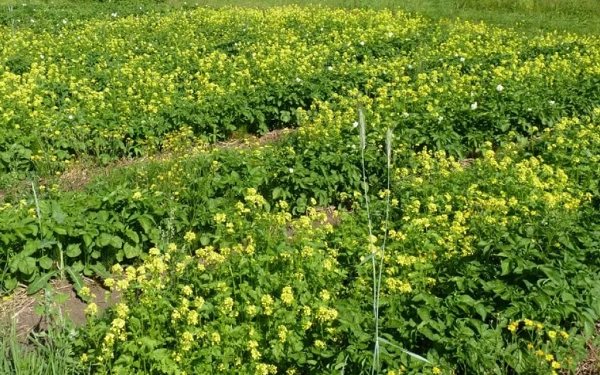

After gaining sufficient vegetative mass, the farmer must decide what he will do - dig up green manure or stop at no-till farming. The first method is easier, but less effective. Having chosen it, you need to wait for the first shoots. It is better to do the digging from 6 to 8 weeks after they appear. During this period, the plant gains maximum strength, and becomes suitable for embedding into the soil with a shovel, plow or cultivator. When digging, it is undesirable to tamp the shoots into the ground - it is necessary to bury them to a depth of 10-15 cm and leave to rot.
If no-till farming was chosen, it is worth considering the flowering period of the culture. It starts three months after sowing the seeds. It is necessary to grind the vegetative mass until this time, until the roots become tough. Culture should not be allowed to bloom. If the mustard is planted in the fall, it should be trimmed before the frost begins.
Sowing mustard in spring
You can sow white mustard at any time from March to August on any type of soil and dig it up in the same year. In the southern regions, you can sow in early spring and from the end of February (after the 20th).
But for greater efficiency, mustard is sown in the spring a month before the sowing date of the main crop, and this is almost any vegetables, berries (especially strawberries) and salad greens.
Important: mustard should not be sown after cruciferous plants (cabbage, radish, radish) - they have common pests and diseases. And turnip does not tolerate mustard, even in the neighborhood.
It is possible and even necessary to sow mustard before breaking up flower beds and flower beds, until bulbous or rhizome flowers are planted, stored for storage.
Important: rotting green manures can inhibit plant growth, so wait at least 1-1.5 weeks after mowing mustard and digging before sowing or planting vegetables and berries.
How to properly wrap mustard
Mustard, sown in the fall, is plowed with the arrival of spring, a few weeks before the planting of the main crop. If the acidity of the soil is high and the humus content is low, the plant will not undergo natural processing and will rot. Then you need to bury some of the grass, and leave the rest on the soil surface as mulch, or add to the compost.
If the green manure was sown in rows, the vegetative mass is pruned with a cultivator or flat cutter, hidden in the aisles and covered up. After 3 weeks, a fruit plant is planted.
The mustard, sown in spring, is cut and tamped into the ground 14 days after the emergence of the shoots. She will have time to decompose by May.After three weeks, another crop can be sown.
Mulching
It is not enough to know how to cut mustard - you must mulch it correctly. The first thing to do is choose the right time for the procedure and get mulch equipment. First, you need to mow the shoots, whose growth has reached 35-40 cm, cut them and distribute them evenly over the field. The roots must be left in the soil in their original form. After a couple of weeks, they will be processed and give the soil useful elements. So the farmer will fertilize the fertile soil surface and will not harm its microflora.
Efficiency
White mustard, when grown as a fertilizer, shows a high degree of efficiency and a number of advantages over other plants used for similar purposes.
Among such advantages, the following features can be distinguished:
- Very fast growth, seedlings appear in just 3 - 4 days after sowing.
- The ability to grow at very low temperature conditionseven when the thermometer shows 0 ° C.
- High index of frost resistance, the emerged seedlings can withstand frosts down to -6 ° C.
- High yield rate, on one hundred square meters can grow up to 400 kg. greenery.
- Balanced composition: the content of nitrogen, potassium and phosphorus in the composition is not more than 1%, and the content of organic matter is about 22 - 25%.
- Additional opportunity to attract beneficial insects, which are engaged in pollination of crops or the destruction of existing pests and parasites.
- The massiveness of the root processes, allowing them to penetrate into the deepest layers soil and have a positive effect on them.
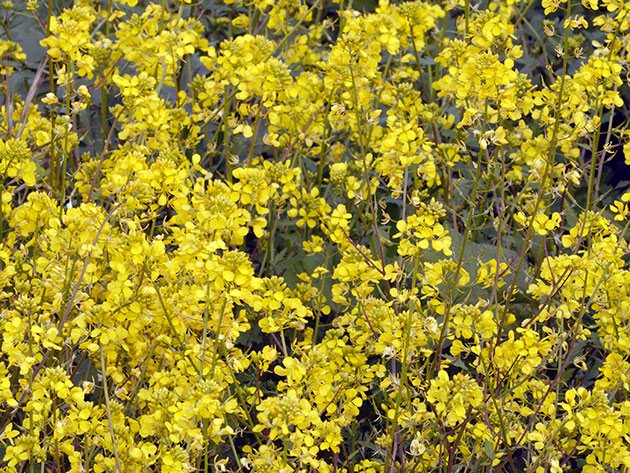

Recommendations for growing mustard
Having conceived to use mustard as a siderat, you should adhere to the rules:
- Although mustard does not impose strict requirements on the soil, it can die due to stagnation of liquid in it. Siderat should not be watered abundantly and often.
- If it is planned to grow radish, cabbage, daikon, turnip in the garden, mustard will not work as a siderat.
- You need to choose the right amount of green manure. If you sow too many of them, the soil will acidify, and this can harm some crops.
- You can not sow siderates and the main crop of one family in turn. So they suffer from infections left over from their predecessors.
- It is impossible to plant the plant immediately after removing the green manure. Mustard releases substances that negatively affect major crops. It is better to wait a few weeks - during this time the earth will recover, and the roots of the plant will get rid of the poison.
- Siderat is often added to compost. In it, it unfolds to the end, giving away all the useful trace elements.
- Mustard sprouts and roots should not become woody before mowing. Ripening of the seeds should also be avoided. Because of it, mustard can grow uncontrollably on the site.
- Mustard is not suitable as a green manure every year. It is better to stick to the crop rotation, alternating the culture with oats, vetch, rye, phacelia.
- Mustard is used for both open ground and greenhouses. There she fully manifests her abilities.
Experienced farmers know green manure is a great alternative to expensive and complex land cultivation methods. Natural farming, especially the use of mustard as a green manure, does not give the worst result. Crop yields are increasing and the land's ecological balance is being restored.
Rate the article:
Rating: 0/5 - 0 votes
Why mustard in the garden?
Interrogating a neighbor with passion, I realized one thing - siderat mustard. By coincidence of life's circumstances, it turned out that we received vegetable gardens with a neighbor at the same time. The soils are pre-scruffy. And we undertook to improve them.
There are very few livestock in our area, and it is quite difficult to improve the land quickly without organic matter. My neighbor and I decided to improve the soil with green manure. But the principle of this method was not clear to me. And the explanation immediately followed.
It turns out that the plant uses the sun's rays to produce organic matter, the process is called photosynthesis. And then we bring this organic matter into the ground. Plant residues will be a nutrient "feeder" for microflora, which will make minerals available to plants.
My neighbor is clever - yes. So why sow mustard and not rye? And as it turned out, here, too, the neighbor is more circumspect. Rye gives huge rhizomes, and it is very difficult to dig up (we do everything by hand), the age is not the same. Mustard is another matter.
As it turned out, mustard has a lot of advantages:
- It has a taproot, which means it loosens the earth deeply, increases the permeability of air and water;
- Frost resistant. At a temperature of 2-4 ᵒC, the growing season is still ongoing, the culture accumulates nutrients;
- Green mass is a good snow retardant;
- Mustard gives off sulfurous substances. Bears, wireworms, slugs, May beetles do not tolerate the smell of spicy culture.
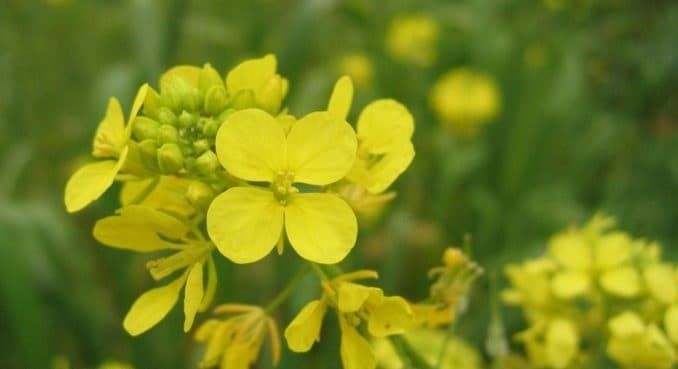

When to sow?
No matter how much I didn’t ask my neighbor when to plant mustard for fertilization in the fall, I couldn’t get an intelligible answer. I had to peep.
As a rule, all green manures are sown in the fall, but the neighbor is not. I look, as soon as he removes some kind of crop, immediately digs up the soil, harrows and tries to sow. I removed the onion, garlic - sowed the mustard. I removed early potatoes - sowed again, late - sowed again. He explains this by the fact that the land should not be empty, let it produce organic matter.
Of course, if the garden is small, then you can run around with a shovel to dig in, and sow, but if it's big? Then plows come to the rescue, since now they are available, from mini to maxi.
Are there any failures?
Not everything worked out so smoothly for me. A neighbor sows - turns green, I sow - everything is black. What's the matter, how to sow mustard on green manure in the fall so that there is a sense?
It turns out that culture has its own "tricks". This spicy herb is very hygrophilous, especially during the period of seed germination. In the initial stages of growth, it also requires rainfall. Maintaining constant moisture by watering is almost impossible, only rain will help us.
The neighbor looks - the rain is going, and in general the weather forecast portends high humidity - which means you need to quickly sow. So I got used to it, and everything fell into place. My mustard is rising thickly. I am on the principle "This is thick - it will not be empty." I do not particularly stand on ceremony with the norms, but I try to withstand the scientific dose of 200 g per hundred square meters.
In addition, failure is possible when the main crop is especially close to the crops of the aromatic crop. For autumn crops this is not scary, but summer crops suffer. As soon as shoots begin, neighboring crops begin to bend, they really do not like the scent of mustard.
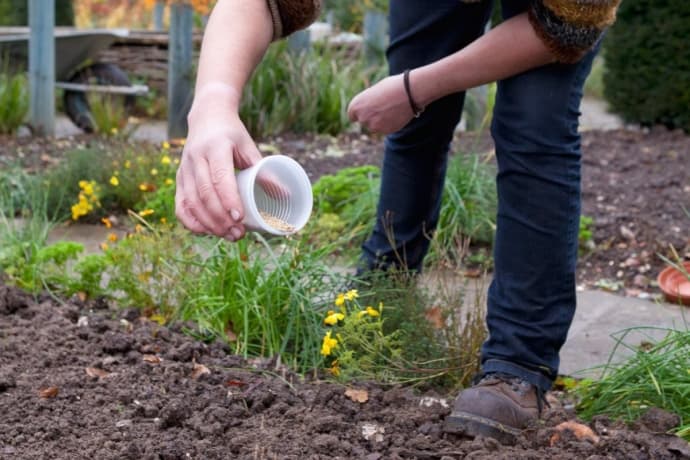

How to deal with crops
I read that the "harvest" is cut before the beginning of budding. Autumn crops, of course, do not have time, but those that are after early crops are driven into the buds.
I'm already adjusting my braid, but my neighbor is in no hurry. I peep, I peep, but he does not mow. I decided to ask. As it turned out, he is not going to. Let, he says, leave the aroma in the winter. If necessary, in the spring we will mow it, let it dry, and then we will dig it up, if the mustard is small, we will dig it up without mowing. And so they did.


